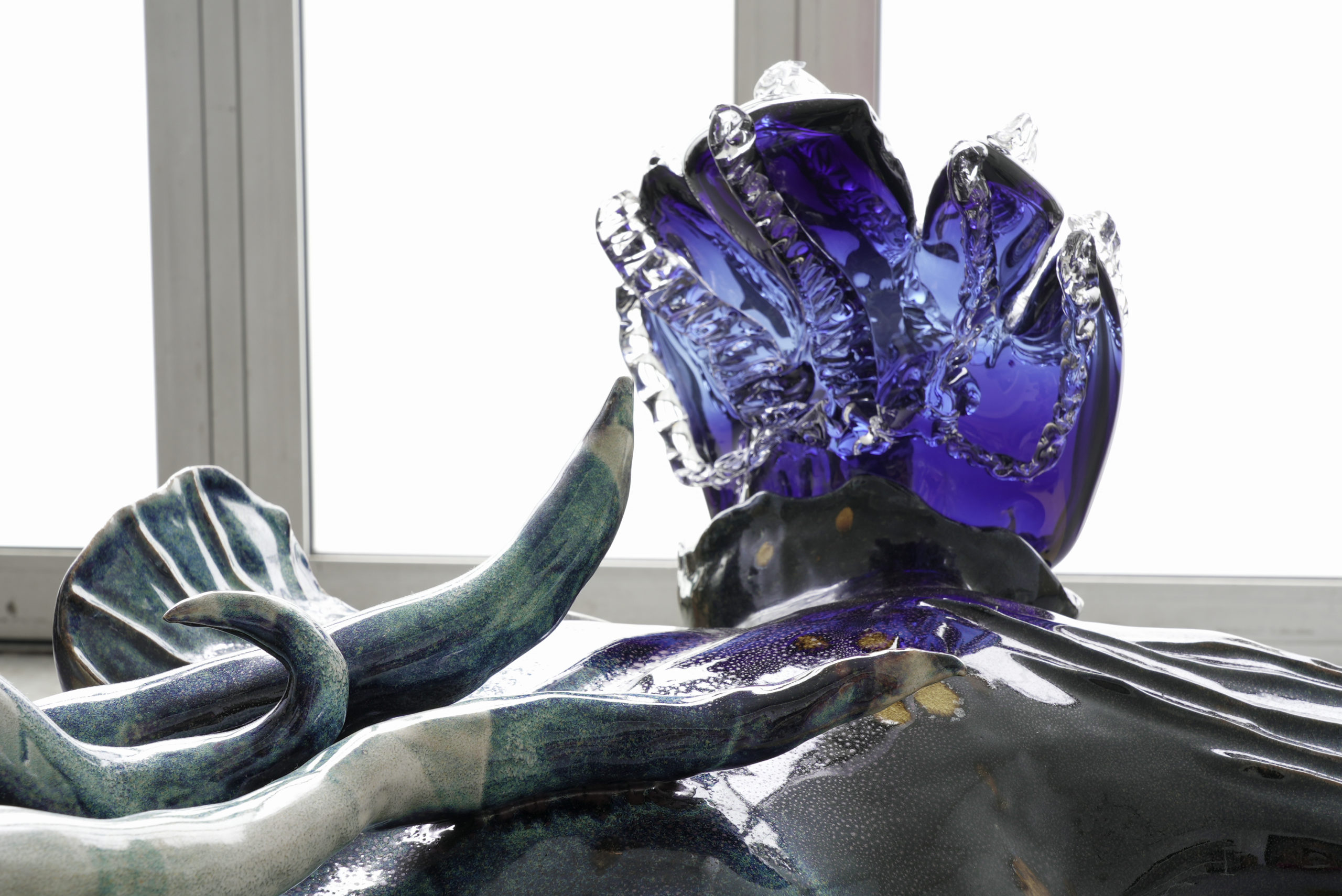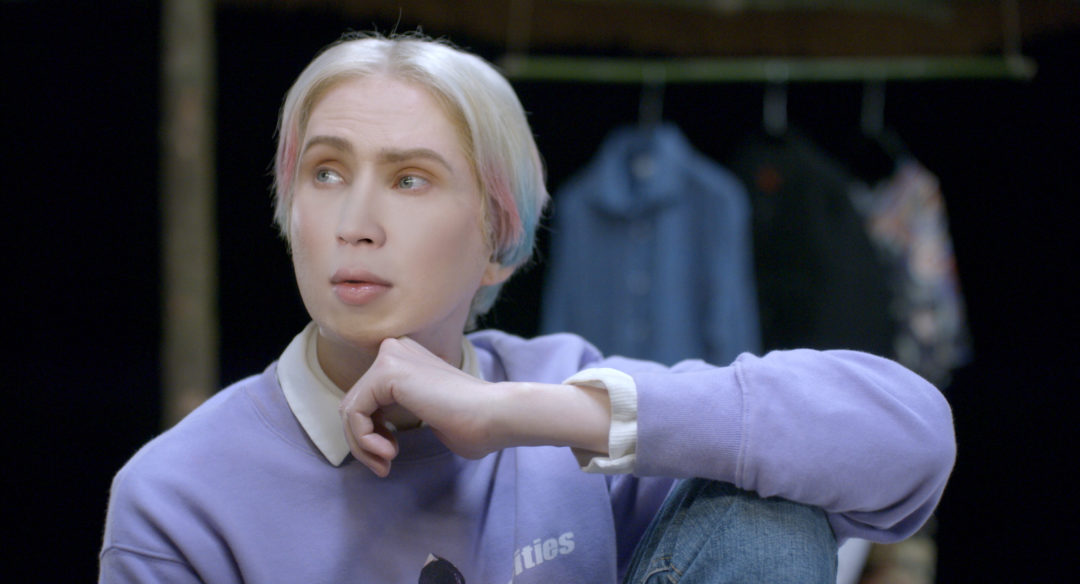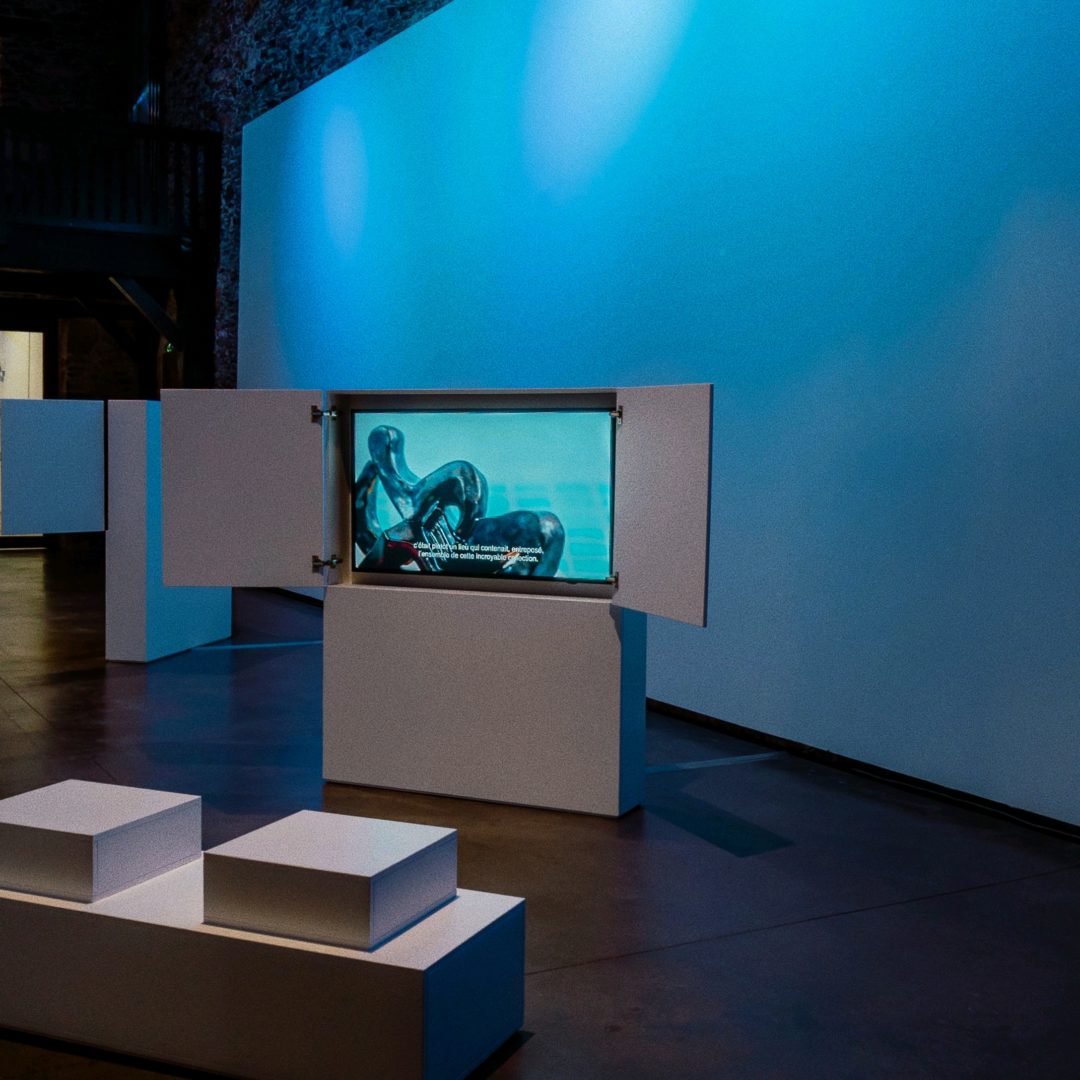Yan Tomaszewski

What can the Churyumov-Gerasimenko comet, Oli London—a London influencer smitten with K-Pop superstar singer Jimin, and the Maslon collection, which was sold to an American buyer who dissembled it in the upheaval, all possibly have in common? In theory, nothing, other than the fact that they are figures that young Parisian artist Yan Tomaszewski has interested himself in. Nothing, aside from each of these topics of investigation having been concluded by a filmed work—falling somewhere between documentary and fiction. Beginning with an anecdote or an established historical fact, legends or myths which link characters with contexts which are more or less real, more or less fictive, the artist then does his utmost to construct imaginary narratives, to pore over connections and dig up hidden genealogies while speculating on possible developments. The point is not to to make a work of scientific research but to embark on a sensorial and inquisitive stroll which causes him to let go of the dramatic arc in order to drift toward psychoanalytic considerations and uncertain mythologies which lead to unexpected appearances of improbable, hybrid forms. For example, he takes South Korean traditional ancestral masks as a jumping-off point in order to question the radical evolution of cosmetic surgery within that country. What if these detours were only a pretext for the production of unprecedented forms of expression?

Yan Tomaszewski is incapable of explaining his initial motivation to begin his latest research project about the Seine. The project, “Sequana” gathers together several “sources” of interest. Archival images in the middle of which a river—the Seine—springs forward are pinned to the wall of the artist’s studio; here, thousands of floating pieces of wood have obscured the river’s surface. The image is so striking that the viewer might wonder if the photograph could in fact be a drawing. The surface of the current is filled from one bank to the other with firewood destined to be fed to chimneys all over Paris. This is how we rediscover a forgotten phenomenon—the literal sucking up of an entire country’s resource by its capital. “Sequana” is the Latin name for the Seine, which was also the name of a goddess who symbolised and was the incarnation of a divinity during the Roman era. It is nevertheless highly probable that this was part of a religion which was already well in place before the Romans arrived, and that once they arrived and swallowed the population already inhabiting the riverbanks, this type of worship continued to be represented—most likely lasting long after Christianity tried to make all pagan forms of worship disappear. Another image posted nearby that of the “nourishing” Seine is Hobbes’ Leviathan—a reference to the cannibalism of a population by a centralised State. One more image gives us clues as to the links the artist attempts to form: a stained glass image of a saint slaying a dragon. The figure of the dragonslaying saint was highly popular in the centuries following the advent of Christianity; they were very present at the time as they had been fused with the local divinities. This type of imagery was common in floodlands, with the monster representing the water which flows through, serpent-like, overflowing and destroying crops, and the saint representing the taming of the natural element by man. The artist depicts the combat of one of these saints with one of these legendary beasts which he shows emerging from the water, like a kind of hydra with enormous tentacles. In the middle of the studio stands a ceramic sculpture which is reminiscent of the aforementioned creature with a strange, hybrid human torso and appendage-like extensions. In “L’atelier de l’eau (The Water Workshop)”, an exhibition at the municipal Jean-Collet gallery in Vitry-sur-Seine, Tomaszewski’s research took on the form of a collaboration with a sculptor who specialises in woodworking in order to create a series of ex-votos using charred wood. Once the charring process culminated in an active charcoal with the aid of a company which specialises in this, the sculptures which result from the combustion of this very specific type of wood were immersed in the Seine following a procession meant to symbolically purify them. Activated charcoal is a material that is currently and widely used in the process of water purification. And so, the artist closes the circle which began with the act of a natural resource being completely sucked up by a capital. Through this same gesture, he resuscitates the old ways of worshipping, mixing mythical references with modern day ecological preoccupations, by creating new artefacts and displaying them in new, performative ways.

Gangnam Beauty—a film which premiered at the IDFA documentary festival in Amsterdam, then at Beaubourg (Centre Georges Pompidou, Paris) on 25th November, 2021 in the presence of its main protagonist, Oli London—explores yet another transhistorical connection. This time, the multi-secular Korean tradition of masks is examined, all the way up to their current-day use, or “upgrade” through the surge in cosmetic surgery in the heart of South Korea, one of the most technologically advanced in Asia. The film focuses specifically on Seoul, and the Gangnam district in particular, where the concentration per square metre of plastic surgeons is the highest in the country.
Like most of the artist’s films, Gangnam Beauty forms several narrative threads at once; one of these threads combines mythological and imaginary references while the other has a documentary-like feel. The latter chronicles the challenges encountered by a young British online personality in the quest to resemble their idol: Jimin, lead singer of the K-Pop group sensation, BTS. Not simply a passing fancy or a vague preoccupation with a certain aesthetic ideal; this obsessional quest takes the protagonist from one corner of the planet to the other in search of the best practitioners to carry out more than twelve procedures ranging from the relatively mundane rhinoplasty—or nose job—to more complex operations which would require several instances of the breaking and reconstruction of London’s jaw. Tomaszewski’s film gives us access to a relatively far-fetched reality which has yet to reach Europe, where aesthetic surgery is less present in contrast with Korean youth who have whole-heartedly embraced the practice. The trend—established in certain regions of Brazil or California—upholds a perfect body or an unlined face as a much sought-after ideal, has been present in these areas for some time now and has slowly but surely become entrenched. For Vincenzo Cicchelli and Sylvie Octobre, the authors of K-Pop, Soft power et culture globale (K-Pop, Soft Power and Global Culture),1the growing culture of aesthetic surgery and the increasing popularity of Korean pop music are two intimately related phenomena. The sudden emergence of a movement which functions based on the supremely magnetic force of extremely clean-cut boys band members is only the tip of the iceberg. According to the authors, the situation is due to a profound upheaval involving the evolution of fundamental societal values as well as the role of the domination of cultural products whose origin is primarily in the United States. The K-Pop tsunami has also spread to young Westerners in search of new themes and images in American culture2. Young Europeans, as well, are seeking alternative paths to the dark extravagance of the guitar hero put forth by dominant culture, and in Hollywood cinema as well, whose dramatizing tropes no longer speak to a young generation with less polarised values. K-Pop heroes channel other, more positive values, where high importance is placed on social adeptness with regard to the still heavily-romanticised image of the brilliant loser. The authors also point out the downside to a culture where young people are expected to strive incessantly toward a better version of themselves, including when it comes to appearance and the fundamental role it plays. They mention the leading stars of K-Pop, who do not hesitate to admit their readiness to go under the knife regularly, sharing their experiences which are posted to social media in the form of video updates. Hence, the face lift has shifted from strictly personal and vaguely shameful practice to self-affirming gesture. To cut to the point, Tomaszewski’s film draws a parallel between the grotesque, carnavalesque practice of mask-wearing—one which is widespread, and which allows the wearer to make pointedly critical remarks about society while remaining protected due to the context and to the dissimulation of the person’s real identity—with a phenomenon where the mask disappears, melting directly into the skin of the “operated” individual. From a societal point of view, a change in function occurs; instead of the societal critiques toward inequality and injustice the practice of mask-wearing permits, there is an identification with normative values imposed by society. Not to mention, of course, the ensuing psychological and identity-related upheavals involved when one undergoes such transformations. In the film, Oli London plays the role of the mask sculptor in the story3 who can never be seen carrying out their work, as well as that of an observer or voyeur who cannot help themselves from transgressing the taboo. Beyond the exploration of a dual personality pulled in different directions by contradictory desires who would be an ideal candidate for psychoanalysis, Tomaszewski’s film also delves into the evolution of an ostensibly advanced and open society who nonetheless masks very effectively collective tensions borne out of a frenetic desire to achieve individual success.

As for the subject of psychoanalysis, The Good Breast and the Bad Breast offers an in-depth look at the topic. The film tells the story of the sale of the Maslon house, built by renowned architect Richard Neutra—who had a pronounced interest in the Freudian discipline—for the couple of art collectors. Shown for the first time at the FID in Marseille in 2019, at the MAK Center for Art and Architecture (USA) in 2020, then at the MABA in Nogent-sur-Marne, before being shown at Zoo Gallery during the “Shelter”4 exhibition4 Tomaszewski’s video examines the ins and outs of a story in which the main protagonists are the architect, the collectors, and lastly, the buyer, who destroys the historic home only days after having acquired it, setting off a storm of indignation amongst the local media. There is no straightforward explanation as to what pushed Richard Rotenberg to do such a thing. The artist makes this enigma the pretext for an elaborate scenario which seeks to elucidate the circumstances behind the situation, led by a group of psychoanalysts, whose voiceovers are heard throughout the video. Their “diagnosis”—which can only be conjectured since the buyer has never been asked the “question”—concluded something along the lines of an impulsive mixture of envy, jealousy and desire for acceptance. The film, which takes the form of an investigation, examines a theory put forward by Mélanie Klein, the author of the book Envie et gratitude (Envy and Gratitude), which considers the home as a protective place which is conducive of creativity, “while the buyer would represent the envy of a bad, destructive breast.” Things become less clear when the film offers theoretical explanations as to the choice of the house; although, clearly it was designed by one the most important architects of his time, which housed a remarkable modern art collection containing works by Lipchitz, Arp, Giacometti and Warhol. And yet, twenty-one years later, there is still no explanation for the reasons behind such a bizarre act. The artist has made a reproduction of the house, along with all of the collected works, which become the real protagonists of this drama. Tomaszewski takes genuine pleasure in re-creating modern works, lingering over the “bad breast” sculpture, as well as over a reconstitution of Ephesus’ Temple of Artemis, one of the seven wonders of antiquity which was destroyed by Herostratus, who represents a parallel to Rotenberg, while the multiple breasts of Ephesus’ Artemis are the “good breast”.The re-enactment of this drama raises many questions as to the psychological implications…

The solar system and the innumerable objects which constitute it is one of the artist’s preferred themes. The Rosetta probe was launched in 2004, intended to land on the Churyumov-Gerasimenko comet in order to analyse the chemical composition of this heavenly object.5 Space expeditions are regularly viewed in a positive light by the scientific community because they hold the potential for discovery which ignites the curiosity of people the world over. They leave almost no-one indifferent to these discoveries which reduce our level of ignorance concerning the origins of our world, for which comets are suspected as having being largely responsible. The “landing” of this micro-vessel in the middle of the 2000s was therefore something like a television series plastered on screens everywhere for several weeks. The artist became vividly interested in the comet and, in his enthusiasm initiated a collaboration with the Air and Space Museum in Bourget. Thoroughly satisfied with having “gotten his hands on” an object which—as became progressively clear through increasingly precise observation—vaguely resembled a diabolo, he was inspired to create a construction which would be installed on the airport tarmac. Glass sculptures whose shape was reminiscent of that of laboratory test tubes were displayed inside this “cave”, while a video featuring the research of Louis le Sergeant d’Hendecourt was projected—the astrochemist studies the conditions of the emergence of life on earth through the use of his famous “elementary bricks” which are extracted from underneath comets. It would appear that the artist, by including images related to alchemy in his film, is trying to draw a parallel between the “Magnum opus” and the modern day quest to make the ultimate scientific discovery—that of the latest astrochemical “protocol” which gave way to the appearance of life. In this sense, Tomaszewski reuses an approach he is fond of and which can be seen throughout the entire body of consequential work—that of establishing narratives which interlace mythology, scientific progress and other anthropological considerations. Which are as good a pretext as any for re-appropriating existing concepts in order to reinterpret them with a malicious, hybridised twist.
______________________________________________________________________________
1 Vincenzo Cicchelli and Sylvie Octobre, K-Pop, Soft power et culture globale, March, 2022, édition Puf.
2 op cit., pg 175.
3 This XIIIth century tale tells the story of a young mask maker ordered by the gods to hide his work or else face death. This practice, which is linked to a shamanic dance associated with the wearing of this mask, is said to still be practiced to this day in Hahoé.
4 https://www.zoogalerie.fr/shelter
5 https://www.macval.fr/Histoires-vraies
6 https://explore.psl.eu/fr/le-magazine/focus/mission-rosetta-le-periple-dune-sonde-spatiale
Head image : Yan-Tomaszewski, vue d’atelier, Cite-internationale des arts, 2023.
Détail du travail en cours pour le projet Sequana. Courtesy de l’artiste.
- From the issue: 104
- Share: ,
- By the same author: Thomas Giraud - Avec Bas Jan Ader,
Related articles
Gregory Sholette
by Ingrid Luquet-Gad
Vera Kox
by Mya Finbow
Fabrice Hyber
by Philippe Szechter

